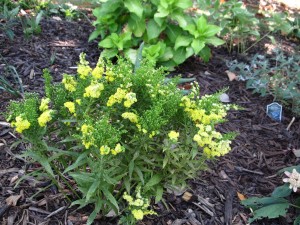Goldenrods are members of the aster family (Asteraceae); approximately 100 species of goldenrods are native to North America. Across most of the Eastern and Midwestern U.S., goldenrods are frequently spotted growing in moist soils in open farm fields, in ditches, and along edges of streams. The golden yellow blooms attract countless bees, butterflies and other pollinators.
A new addition to my garden is ‘Little Lemon’ goldenrod (Solidago Little Lemon (‘Dansolitlem’ PP17297)]. Little Lemon is an exceptionally compact goldenrod with bright lemony yellow flowers that bloom from late July into August (USDA hardiness zones 5-8). Soft yellow is a sharp departure from the mustard yellow color of most goldenrods. Deadheading will induce secondary flowering into September.
Wild goldenrod species grow tall, much too big for most urban gardens. Compact growing Little Lemon should please city gardeners with limited growing space. Newly set plants should be mulched and watered regularly the first season until established. Established goldenrods are among the most drought tolerant perennials.
Fertilize at planting time and in late winter in successive years with 10-10-10 or equivalent. Few diseases and pests trouble goldenrods. Rust seems to be the biggest culprit, particularly if summer weather is unusually wet. Rust rarely kills goldenrod.
Little Lemon goldenrod combines well with other late summer blooming perennials and annuals such as Japanese asters (Kalimeris), ‘Short and Sassy’ heleniums, blanket flowers (Gaillardia), stone crop (Sedum), and stokes asters (Stokesia) in garden beds and mixed in containers. Their bright yellow flowers are great additions to fresh or dried flower arrangements.
Goldenrods hold their form through most of winter. On a brisk cold winter morning a hoarfrost over the skeletal remains of goldenrods is an inspiring view.


 Posted in
Posted in 
